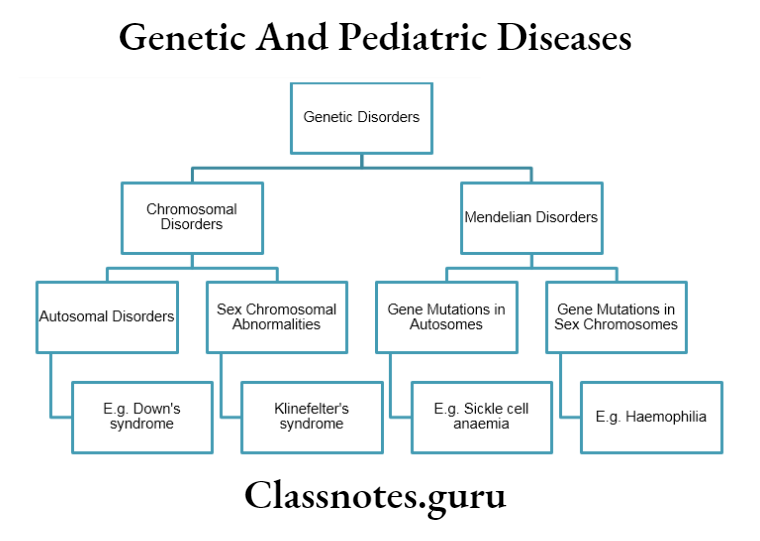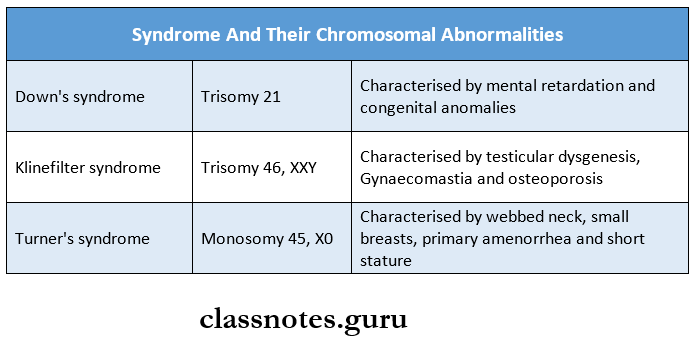Genetic And Pediatric Diseases Important Notes

1. Syndrome and their chromosomal abnormalities

2. Structural abnormalities of chromosomes include
- Translocation
- Deletions
- Inversion
- Ring chromosome
- Isochromosome
Genetic And Pediatric Diseases Short Essays
Question 1. Down’s syndrome
Answer:
- Down’s syndrome/trisomy 21/mongolism affects approximately 1 in 1000 births.
- It is the most common chromosomal disorder and is the commonest cause of mental retardation.
Down’s syndrome Etiology:
- Late maternal age
- Nondisjunction of chromosome 21 during an early stage of embryogenesis.
Down’s Syndrome Clinical Features:
- Epicanthal folds and flat facial profile,
- Slanting eyes produce a mango-loid appearance.
- Hands are short with a transverse single palmar crease.
- Abnormalities of ears, trunk, pelvis, and phalanges
- Cardiac malformations
- Congenital malformations are common and quite disabling
- Risk of developing acute leukemias, especially mega-karyotypic leukemia.
- Oral manifestations:
- Deficient maxilla – class 111 relation,
- Open mouth,
- Large tongue,
- Caries free teeth due to excess salivation.
Read And Learn More: Pathology Question And Answers
Genetic And Pediatric Diseases Short Questions And Answers
Question 1. Chromosome mutations
Answer:
- Mutation refers to permanent changes in the DNA. The genetic disorders arising from chromosomal aberrations are a consequence of numeric or structural abnormalities in the chromosomes.
- General features of chromosomal disorders and specific examples of diseases involving changes in the karyotype are as follows:
- Chromosomal disorders resulting from mutations may be associated with absences/excess of chromosomes.
- Absence-monosomy
- Excess – trisomy.
- Generally, the loss of chromosomes produces more severe defects than the gain of chromosomes.
- Excess chromosomal material may result from a complete chromosome as in trisomy or a chromosome as in Rebortsonian translocation.
- Imbalances of sex chromosomes are tolerated much better than similar imbalances of autosomes.
Question 2. Inborn errors of metabolism
Answer:
- Storage diseases or inborn errors of metabolism are biochemically distinct groups of disorders occurring due to genetic defects in the metabolism of carbohydrates, lipids, and proteins resulting in intracellular accumulation of metabolites.
- Based on the biochemical composition, storage diseases are classified into distinct groups.
1. Glycogen storage disease: There is defective glucose metabolism resulting in excessive intracellular accumulation of glycogen.
Example:
- Von Gierke’s disease,
- Pompe’s disease,
- Mcardle’s disease etc.
2. Mucopolysacchari doses:
This results from a deficiency of specific lysosomal enzymes involved in the degradation of mucopolysaccharides/glycosaminoglycan- cans and is therefore, a form of lysosomal storage disease.
3. Other types:
- Sphingolipidoses/gangliosidoses – accumulation of gangliosides
- Gaucher’s disease – accumulation of glucose- offside.
- Niemann-pick diseases-accumulation of sphingomyelin.
Question 3. Erythroblastosis fetalis.
Answer:
Erythroblastosis fetal/Haemolytic disease of the newborn results from the passage of IgG antibodies from the maternal circulation across the placenta into the circulation of fetal red cells.
HDN can occur in 2 ways.
1. Incompatibility of ABO or Rh blood group system.
- Severest from may result in intrauterine death from hydrops fetal.
2. HDN due to ABO incompatibility.
- Occurs most frequently in infants born to group O mothers who possess anti-A /anti-B IgG antibodies.
